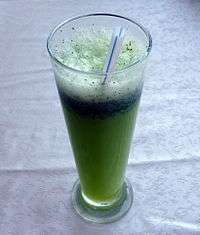Lemonade
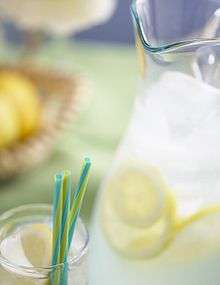
Lemonade is the name for a number of sweetened beverages found around the world, all characterized by lemon flavor. Most lemonade varieties can be separated into two distinct types: cloudy, and clear, each known simply as "lemonade" in countries where dominant.[1] Cloudy lemonade, generally found in North America and India, is a traditionally homemade drink made with lemon juice, water, and sweetened with cane sugar or honey.[2] Found in the United Kingdom, Ireland, South Africa, Australia, and New Zealand, Clear lemonade is a lemon, or lemon-lime flavored, carbonated soft drink.
A popular variation is pink lemonade, made with added fruit flavors such as raspberry or strawberry among others, giving a distinctive pink color.[3] The "ade" suffix may also be applied to other similar drinks made with different fruits, such as limeade, orangeade, or cherryade.[4] Alcoholic varieties are known as hard lemonade.
In many European countries, the French word limonade has come to mean "soft drink," regardless of flavor.
History
As lemons and sugarcane are native to India, it is safe to assume the Indians first consumed a type of lemonade called Nimbu Pani, meaning lemon water, literally. Another name for this beverage is Shikanjvi.
The earliest written evidence of lemonade has been found in Egypt, dated to around AD 1000, It is believed that the fruit was introduced from Asia around AD 700.[5] Here, a wine made with lemons, dates, and honey was enjoyed by peasants, and bottles of lemon juice with sugar, known as qatarmizat were imported and consumed locally.[6]
In 1676, a company known as Compagnie de Limonadiers was founded in Paris.[7] Having been granted monopoly rights to sell lemonade, vendors roamed the streets serving the drink in cups from tanks on their backs.
The first reference found to a carbonated lemonade was in 1833.[8]
Varieties

Cloudy lemonade
The predominant form of lemonade found in the US, Canada, and India, cloudy lemonade, also known as "traditional lemonade" in the UK and Australia, is typically non-carbonated and made with fresh lemon juice, however commercially produced varieties are also available. Generally served cold, cloudy lemonade may also be served hot as a remedy for congestion and sore throats,[9] frozen, or used as a mixer.
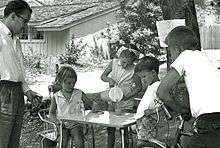
Traditionally, it is common for children in US and Canadian neighborhoods to start lemonade stands to make money during the summer months. The concept has become iconic of youthful summertime Americana to the degree that parodies and variations on the concept exist across media. References can be found in comics and cartoons such as Peanuts, and the 1979 computer game Lemonade Stand. Recently, the subject has attracted controversy as some unlicensed lemonade stands have been shut down due to health regulations.[10]
Pink lemonade
A popular variation of cloudy lemonade, pink lemonade is created by adding additional fruit juices, flavors, or food coloring to the recipe. Adding flavor, and a distinctive pink coloring, possible additions may include raspberries, strawberries, cherries, red grapefruit, grapes, cranberries, grenadine,[3] or the fruit of the Staghorn Sumac.[11] The invention of pink lemonade was credited to Henry E. "Sanchez" Allott as the inventor of pink lemonade in his obituary in The New York Times, saying he had dropped in red cinnamon candies by mistake.[12] Another theory, recorded by historian Joe Nickell in his book Secrets of the Sideshows, is that the drink was first invented in 1857 by Pete Conklin, when he made lemonade using water dyed pink from a horse rider's red tights.[13]
Clear lemonade
Popular in the United Kingdom, Australia, and New Zealand, clear lemonade is a carbonated, lemon flavored soft drink. In countries where clear lemonade is dominant, American lemon-lime sodas such as Sprite are also referred to colloquially as lemonade.
Clear lemonade can be consumed on its own or as a mixer. Mixed with beer, clear lemonade is used to make shandy, it is also an important ingredient in the Pimm's Cup cocktail.
In Ireland, lemonade is available as a clear "white lemonade", as well as in red and brown varieties. Despite the three flavors, differences in taste between the three have been disputed.[14] Red lemonade is a popular mixer, especially with whiskey,[15] and has become the center of a popular urban myth. It has been believed that European Union authorities planned to ban the drink, when in fact they were only banning certain carcinogenic dyes.[16]
Other varieties
In India and Pakistan, where it is commonly known as limbu paani or nimbu paani, lemonade may also contain salt and/or ginger juice. Shikanjvi is a traditional lemonade from this region, and can also be flavored with saffron, and cumin.[17][18]
Limonana, a type of lemonade made from freshly squeezed lemon juice and mint leaves, is a widely popular summer drink in Israel, Jordan, Lebanon, and Syria.[19] Limonana was created in the early 1990s in Israel after an advertising agency promoted the then-fictitious product to prove the efficacy of advertising on public buses. The campaign generated so much consumer demand that restaurateurs and manufacturers began really producing the drink, which would become very popular.[20][21]
Switcha is a version of the drink made in the Bahamas and Turks & Caicos that can also be made with limes instead of lemons.
Citron pressé
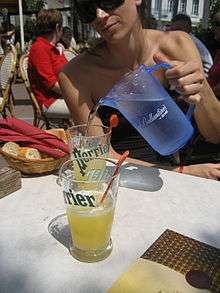
In France, it is common for restaurants to offer citron pressé, an unmixed version of lemonade in which the customer is given lemon juice, syrup and water separately to be mixed in their preferred proportions.[22] A Guardian article on British Francophiles commented that "it used to be that a gaggle of women drinking citron pressés would silently compete to see who could add the least sugar, thereby proving their ultra-refined taste for sourness."[23]
Limeade
Limeade is a variation of lemonade, substituting lemon juice or flavoring with lime. Like lemonade, both cloudy and clear varieties exist. It is especially popular in nations where limes are common, such as Guyana and Trinidad, as well as India, Pakistan, Thailand and throughout South-East Asia. A Thai-styled limeade tastes salty, and sometimes does not have any sugar.[24]
Most major beverage companies now offer their own brand of limeade, such as A.G. Barr of Glasgow and Newman's Own since 2004, with Minute Maid introducing a Cherry Limeade drink in response to the popularity of Limeade.[25] Sonic Drive-In also offers a cherry limeade.[26]
Health benefits
Like other citrus-fruit based products, lemonade has been promoted as healthful due to its high concentration of vitamin C. However, the drink's health benefits will be highly limited in many diets due to its very high sugar content.
Daily consumption of 120 ml (4 imp fl oz; 4 US fl oz) of lemon juice per day, when mixed with two litres of water, has been shown to reduce the rate of stone formation in people susceptible to kidney stones. Lemons contain the highest concentration of citric acid of any fruit, and this weak acid has been shown to inhibit stone formation.[27]
In popular culture
First coined by Christian anarchist writer and philosopher Elbert Hubbard in a 1915 obituary for dwarf actor Marshall P. Wilder,[28] the phrase "When life gives you lemons, make lemonade" has come to encourage optimism in the face of adversity.
Gallery
-
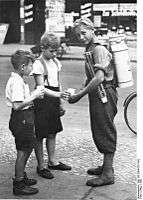
Selling lemonade in Germany during 1931
-
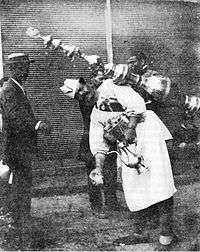
Lemonade seller in Selânik, Ottoman Empire (pre-1890)
-
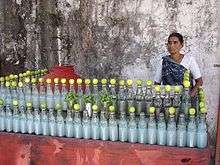
A lemonade seller, with Banta soda bottle, India.
-
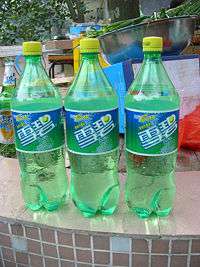
Chinese Sprite
-
.jpg)
A glass of limeade
-
.jpg)
Limonade
See also
- Ade (drink Suffix)
- Lemon-Lime Drink
- Lemon Squash
- Lemon, Lime and Bitters
- Chanh muối
- List of juices
- List of lemon dishes and beverages
References
- ↑ Muir, Alana. An American Guide to Britishness. Lulu.com. ISBN 9781471785467.
- ↑ "History of Lemonade". Buzzle. Retrieved 2015-12-26.
- 1 2 "An Easy to Prepare Old Fashioned Southern Beverage Favorite". Soulfoodandsoutherncooking.com. Retrieved December 30, 2012.
- ↑ Smith, Andrew F. (2013-10-28). Food and Drink in American History: A "Full Course" Encyclopedia. ABC-CLIO. ISBN 9781610692335.
- ↑ "The History of Lemonade". www.frontiercoop.com. Archived from the original on 27 December 2016. Retrieved 2015-12-26.
- ↑ "Did You Know: Food History - History of Lemonade". www.cliffordawright.com. Retrieved 2015-12-26.
- ↑ "The Victoria Advocate - Google News Archive Search". news.google.com. Retrieved 2015-12-26.
- ↑ Emmins, Colin (1991). SOFT DRINKS - Their origins and history (PDF). Great Britain: Shire Publications Ltd. ISBN 0 7478 0125 8.
- ↑ "Is Lemonade Good for Sick People to Drink While They Have the Flu?". LIVESTRONG.COM. Retrieved 2015-12-26.
- ↑ Jung, Helen (August 4, 2010), Portland lemonade stand runs into health inspectors, needs $120 license to operate, OregonLive
- ↑ Lee Allen Peterson, Edible Wild Plants, (New York City: Houghton Mifflin Company, 1977), p. 186.
- ↑ "Inventor of pink lemonade dead." (PDF). New York Times. September 18, 1912. p. 11. Retrieved September 21, 2007.
- ↑ "What is Pink Lemonade". Chowhound.com. October 30, 2007. Retrieved December 30, 2012.
- ↑ "What is Red Lemonade? (with pictures)". wiseGEEK. Retrieved 2015-12-26.
- ↑ "Mixers: red lemonade". Liquid Irish. August 29, 2008. Retrieved December 30, 2012.
- ↑ "Straight bananas: How Euromyths bend the truth". Irish Independent. April 25, 2000.
- ↑ Jiggs Kalra, Pushpesh Pant, Classic cooking of Punjab, Allied Publishers, 2004, ISBN 978-81-7764-566-8, https://books.google.com/books?id=HHrUDlo0DfEC
- ↑ Julie Sahni, Indian regional classics: fast, fresh, and healthy home cooking, Ten Speed Press, 2001, ISBN 1-58008-345-5, 9781580083454, https://books.google.com/books?id=nmYgmJGR2vUC, "... Ginger Limeade (Shikanji) ..."
- ↑ "Limonana: Not your average lemonade". Zomppa. August 29, 2011. Retrieved May 28, 2012.
- ↑ Martinelli, Katherine (July 11, 2011). "Limonana: Sparkling Summer". Jewish Daily Forward. Retrieved May 28, 2012.
- ↑ Siegal, Lilach (May 29, 2001). לימונענע וירטואלית [Virtual Limonana]. The Marker (in Hebrew). Retrieved May 28, 2012.
- ↑ Rough Guides Snapshot (12 April 2012). Poitou-Charentes and the Atlantic Coast Rough Guides Snapshot France (includes Poitiers, La Rochelle, Île de Ré, Cognac, Bordeaux and the wineries). Rough Guides Limited. p. 96. ISBN 978-1-4093-6293-7.
- ↑ Moore, Victoria. "In the drink: stay sharp". The Guardian. Retrieved 2 April 2016.
- ↑ Jordan, Michele Anna (2011-10-11). California Home Cooking: 400 Recipes that Celebrate the Abundance of Farm and Garden, Orchard and Vineyard, Land and Sea. Houghton Mifflin Harcourt. ISBN 1558325972.
- ↑ "Minute Maid Cherry Limeade" (PDF).
- ↑ Todd Wilbur (29 January 2002). Top Secret Recipes--Sodas, Smoothies, Spirits, & Shakes: Creating Cool Kitchen Clones of America's Favorite Brand-Name Drinks. Penguin Group US. p. 20. ISBN 978-1-101-11867-2.
- ↑ "Five Ways to Prevent Kidney Stones" (Press release). UC San Diego. April 22, 2010. Retrieved August 14, 2012.
- ↑ "Selected Writings of Elbert Hubbard (1922) - Volume 5 - The Elect : Elbert Hubbard : Free Download & Streaming". Internet Archive. Retrieved 2015-12-28.
External links
| Wikibooks Cookbook has a recipe/module on |
| Wikimedia Commons has media related to Lemonade. |
- Of the Street Sale of Ginger-Beer, Sherbet, Lemonade,&C., from London Labour and the London Poor, Volume 1, Henry Mayhew, 1851; subsequent pages cover the costs and income of street lemonade sellers.
